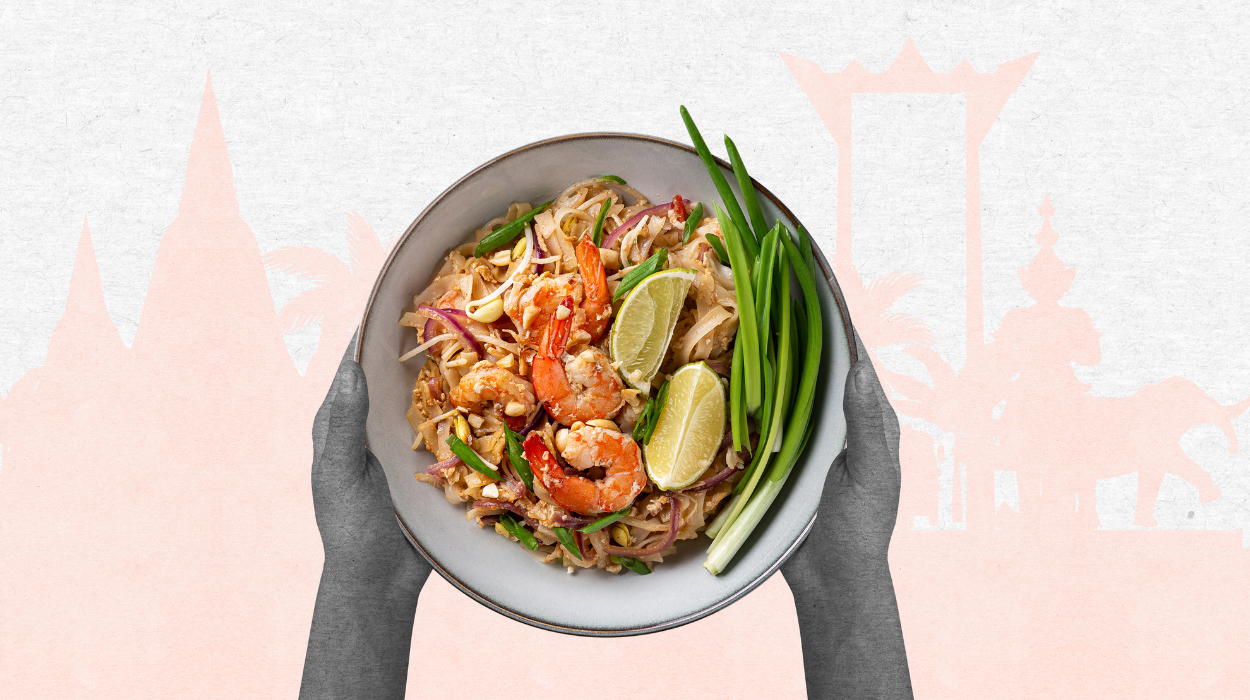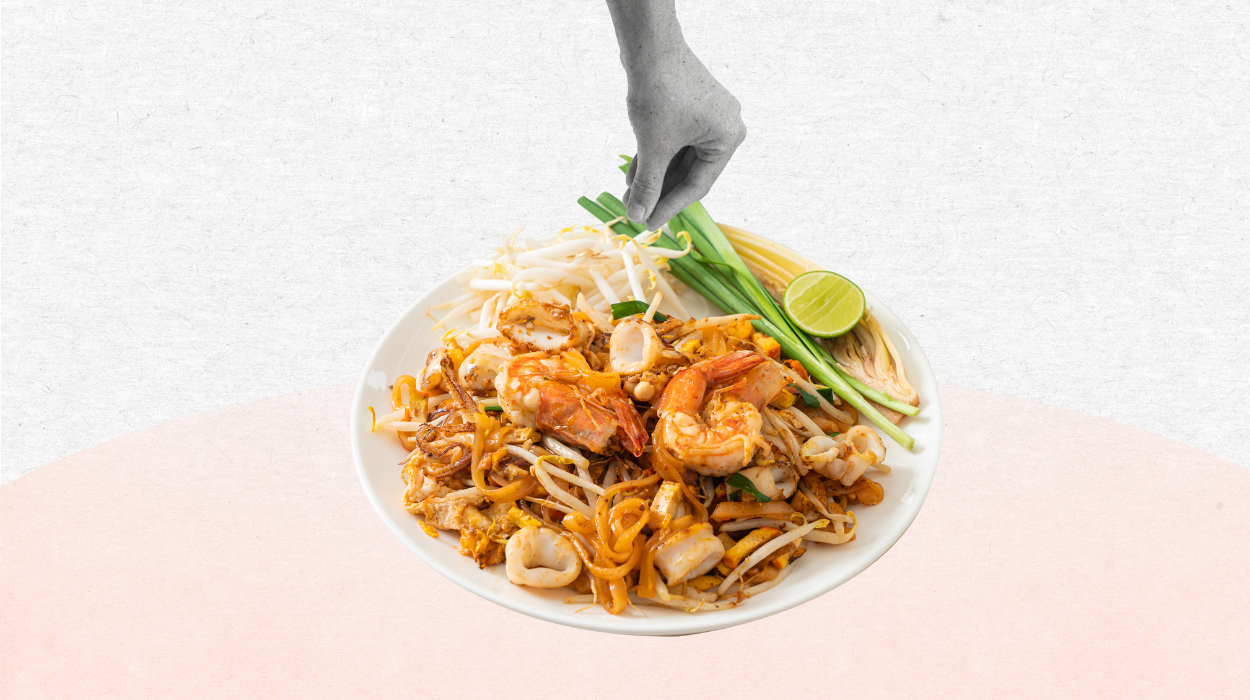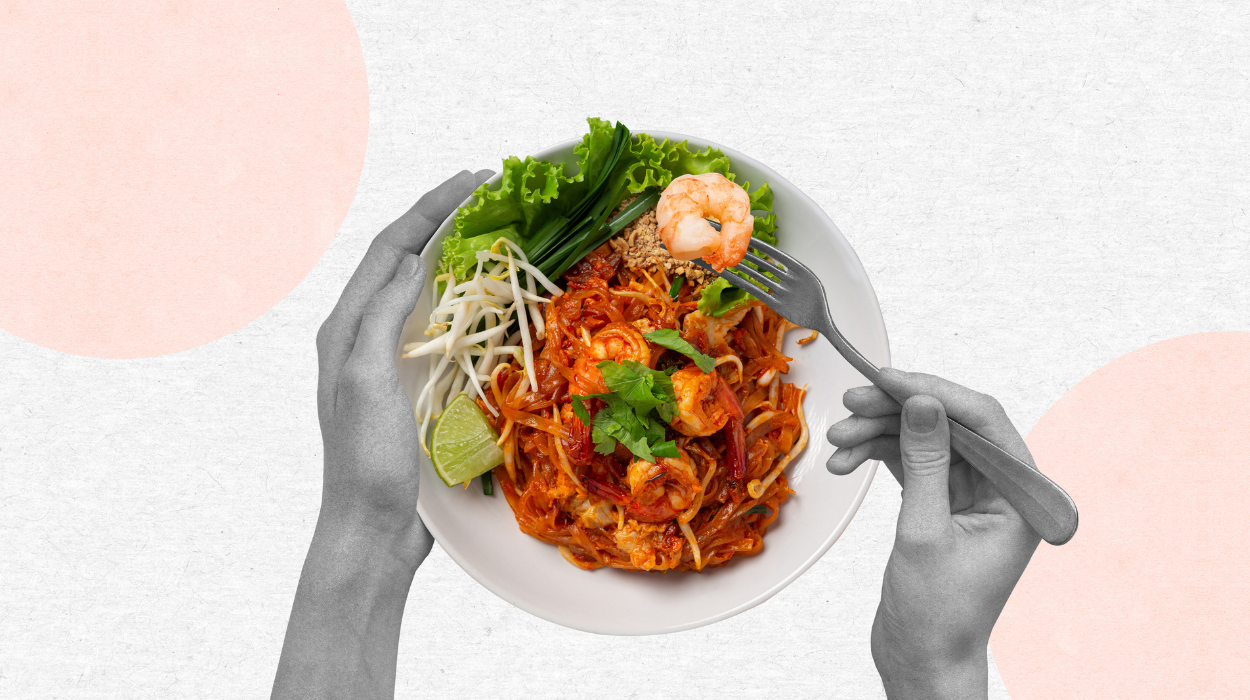 Evidence Based
Evidence Based
Evidence Based
This article is objectively based on relevant scientific literature, written by experienced medical writers, and fact-checked by a team of degreed medical experts.
Our team of registered dietitian nutritionists and licensed medical professionals seek to remain objective and unbiased while preserving the integrity of any scientific debate.
The articles contain evidence-based references from approved scientific sites. The numbers* in parentheses (*1,2,3) will take you to clickable links to our reputable sources.
Is Pad Thai Gluten Free? Exploring Thai Cuisine On A Gluten-Free Diet In 2024

Pad Thai is a beloved culinary gem from Thailand known for its rich flavors and textures. The traditional base of this dish is gluten-free rice noodles. This leads many to believe that Pad Thai is naturally gluten-free. But answering the question, “Is Pad Thai gluten-free” isn’t as straightforward as it might seem.
Many other ingredients used in traditional Pad Thai recipes can be a source of concern for individuals with sensitivities. Let’s dive deeper into Pad Thai to determine if it is safe for those with gluten sensitivity or celiac disease.
Does Pad Thai Have Gluten?
Pad Thai is typically considered gluten-free because it’s made with rice noodles. A traditional Pad Thai recipe may also include bean sprouts, green onions, fresh lime juice, and other gluten-free ingredients.
Still, it’s essential to verify ingredients because the savory sauce used in most recipes may contain gluten. Therefore, you must inquire about gluten-containing ingredients to stick to your dietary restrictions when dining at Thai restaurants.
Is Pad Thai Normally Gluten-Free?
Pad Thai is a renowned dish from Thailand that is primarily made with rice noodles. At first glance, one might assume that Pad Thai is safe for those avoiding gluten because rice noodles are naturally gluten-free.[1] However, the other ingredients used in the dish require a closer look.
The base ingredient of Pad Thai is acceptable for individuals following a gluten-free diet. Rice, in most forms, does not contain gluten. This makes it a staple for those with gluten sensitivity and celiac disease. However, many Pad Thai sauces and preparations are a different story.
Pad Thai uses various sauces depending on how it’s prepared. Soy sauce and certain fish sauces used in the dish typically contain wheat or wheat derivatives,[2] making them sources of gluten.
Many restaurants and meal delivery services also include other gluten-containing ingredients or additives. Even trace amounts can be an issue for individuals following a gluten-free diet.
When dining out, asking your Thai restaurant about their specific recipe is essential. This is the best way to determine whether a Pad Thai dish is truly gluten-free. Since cross-contamination can be an issue,[3] notify your server of your gluten sensitivity.
When preparing Pad Thai at home, it’s essential to source gluten-free variants of traditional ingredients that contain wheat or wheat derivatives.
Exercising caution and asking about specific ingredients ensures your meal meets your dietary requirements. With some extra effort, you can enjoy gluten-free Pad Thai without worry.
What Is Pad Thai?
Pad Thai is an emblematic Thai cuisine that has risen in global popularity. The origins of Pad Thai are often debated, with some claiming it has ancient roots in Thai culture and others crediting China.
Best known as a stir-fried noodle dish, it’s typically served as a street food in Thailand. The dish itself masterfully blends sweet, savory, sour, and spicy flavors to create a delicious balance foodies love.
The foundation of Pad Thai is rice noodles. They are typically thin and flat rice noodles, stir-fried with various ingredients that vary from one dish to the next. Many Pad Thai lovers choose shrimp, tofu, chicken, or a mix of these proteins to enhance their meals.
The true magic of this culinary treat lies in the sauce. A delectable blend of tamarind paste, fish sauce, and sugar, the dish comes together to excite the taste buds.
These spices are combined with an aromatic ensemble of garlic, shallots, and eggs to complete the flavors. Some preparations also include a hint of chili.
Tips To Make Gluten-Free Pad Thai
Making a delicious gluten-free Pad Thai requires simple ingredient adjustments to ensure it adheres to your dietary standards. Here are some tips:
- Choose Authentic Rice Noodles: Since rice noodles are naturally gluten-free, don’t stray from the standard base of authentic Pad Thai. Choose a brand that’s specifically labeled as certified gluten-free to avoid cross-contamination.
- Opt For Gluten-Free Soy Sauce Or Soy Sauce Alternatives: Use gluten-free tamari or coconut aminos instead of soy sauce to maintain traditional flavors and avoid gluten. You can also find a certified gluten-free soy sauce.
- Check Your Fish Sauce: Not all fish sauces are created equal. Check your fish sauce label to ensure it doesn’t contain gluten derivatives that can compromise your diet.
- Use Fresh Ingredients: Use fresh shrimp, tofu, or chicken to ensure no gluten-containing marinades are used to flavor your protein. Add naturally gluten-free vegetables such as bean sprouts, bell pepper, and green onions.
- Create Homemade Sauces: Make your own Pad Thai sauce at home to ensure your recipe includes gluten-free ingredients.
- Use A Clean Cooking Space And Separate Cookware: Ensure your cooking space and utensils are free from gluten residue. Prevent cross-contamination by preparing your gluten-free Pad Thai in separate pans and serving plates from regular dishes.
Ingredients You Need For Gluten-Free Pad Thai
Preparing this culinary delight requires a carefully curated set of ingredients. Each adds its unique touch to the combination of flavors. Pad Thai recipes typically include:
- Rice noodles as the gluten-free backbone of the dish.
- Shrimp, tofu, or chicken for protein. Check to make sure no gluten-containing marinades are used.
- Tamarind paste is naturally gluten-free and gives the dish its tangy sauce flavor.
- Fish sauce is a vital ingredient. However, check labels carefully to opt for a gluten-free Pad Thai sauce.
- Sugar counterbalances the tangy flavors with some added sweetness.
- Chili flakes are optional for heat enthusiasts.
- Garlic and green onions are two more fundamental ingredients of the traditional recipe.
- Eggs should be briefly scrambled before being added to the dish.
- Bean sprouts offer a crisp and refreshing touch.
- Many restaurants and gluten-free meal delivery services include lime wedges, cilantro, and crushed peanuts as a garnish.
How To Enjoy Gluten-Free Pad Thai
Many don’t realize that gluten-free Pad Thai is a versatile dish that can be enjoyed in various ways. Here’s a list of ideas to help you savor this delicious noodle dish:
Traditional Style

Add shrimp or chicken, and enjoy this savory dish in its traditional form. Don’t forget to add crushed peanuts, lime wedges, and fresh cilantro to garnish.
Vegan Pad Thai
Replace the fish sauce with a vegan alternative and choose tofu or tempeh as your protein. Since many vegans must take supplements and a daily multivitamin to balance their diet,[4] incorporating tofu into your Pad Thai can increase your protein intake. You can also supplement with gluten-free protein powders as needed to further boost the protein content of your diet.
Spice Things Up
Drizzle spicy Sriracha sauce, chili powder, or crushed red pepper flakes to add some medium-high heat.
Create A Seafood Delight
Serve Pad Thai with a mix of seafood like shrimp, squid, mussels, and clams.
Create A Breakfast Rendition
Encase your Pad Thai in a thin omelet for a different texture or to enjoy the dish as a breakfast option.
Cold Salad
Enjoy it cold, like a noodle salad. This is an excellent choice if you’re looking for a refreshing dish for warm days.
Soup Style
Add a broth base to your Pad Thai to turn it into a slurpy noodle soup. This can be a great option if you’re under the weather or want to warm up on a cold night.
Experiment With Alternative Proteins
Add beef strips, duck, turkey, and other proteins to customize the dish with proteins you love. Protein is a good source of vitamins, so including various proteins can enhance the nutritional value of a healthy Pad Thai recipe.
Add A Side

If you want a more hearty meal, pair your dish with sides. Pad Thai goes great with Thai spring rolls, satay skewers, and spicy papaya salad.
The beauty of Pad Thai is its adaptability. You can get creative and experiment with endless variations that suit your individual taste and dietary preferences.
Gluten-Free Thai Cuisine Substitutions
Many Thai dishes are gluten-free due to their emphasis on rice and rice-based products. However, common Thai cuisine ingredients like soy sauce may contain gluten.
Here are some tips for gluten-free Thai cuisine substitutions:
- Replace soy sauce with gluten-free tamari or coconut aminos for an umami flavor without gluten.
- Choose a fish sauce that’s specifically labeled gluten-free.
- Swap wheat-based noodles for rice, mung bean, or other gluten-free alternatives.
- Use arrowroot powder, tapioca starch, or cornstarch to replace wheat flour for thickening sauces.
- Use rice paper wrappers for spring rolls and other wrapped delicacies.
- Ensure fried foods are battered with rice flour, chickpea flour, or potato starch.
- Make curry pastes and oyster sauce using fresh ingredients to avoid gluten-containing additives.
- Craft your own dressings using lime juice, chilies, and sugar.
- Opt for rice-based desserts and check that sauces or coatings don’t contain gluten.
The Bottom Line
While the primary ingredient in Pad Thai is gluten-free, it’s essential to check that other dish components don’t contain gluten. To ensure a completely gluten-free experience, you’ll need to select ingredients carefully. This is especially true when dining out.
With some awareness and extra attention, embracing this masterful blend of Thai flavors is entirely possible with a gluten-free diet.
Frequently Asked Questions
Yes. You can eat the popular Thai dish on a gluten-free diet with careful ingredient selection, especially Pad Thai sauce.
Pad Thai uses inherently gluten-free rice noodles. Always check to make sure the recipe isn’t processed with gluten-containing ingredients.
While many wonder does Pad Thai have gluten, the status of Pad Thai, otherwise known as pad see ew, is also commonly questioned. Pad see ew typically uses soy sauce, which can contain gluten. Therefore, it’s critical to verify ingredients before consuming.
Cool the dish to room temperature and place it in an airtight container. You can refrigerate it for 3-4 days. You can freeze it for longer storage, but it’s important to note that textures may change once reheated.
No. There is no gluten in shrimp.
+ 4 sources
Health Canal avoids using tertiary references. We have strict sourcing guidelines and rely on peer-reviewed studies, academic researches from medical associations and institutions. To ensure the accuracy of articles in Health Canal, you can read more about the editorial process here
- Islamiyat Folashade Bolarinwa and Oyewole Oluwaseun Oyesiji (2021). Gluten free rice-soy pasta: proximate composition, textural properties and sensory attributes. Heliyon, [online] 7(1), pp.e06052–e06052. doi:https://doi.org/10.1016/j.heliyon.2021.e06052.
- Lebwohl, B., Cao, Y., Zong, G., Hu, F.B., Peter, Neugut, A.I., Rimm, E.B., Sampson, L., Dougherty, L., Giovannucci, E., Willett, W.C. and Chan, A.T. (2017). Long term gluten consumption in adults without celiac disease and risk of coronary heart disease: prospective cohort study. BMJ, [online] pp.j1892–j1892. doi:https://doi.org/10.1136/bmj.j1892.
- Wieser, H., Segura, V., Ángela Ruiz-Carnicer, Sousa, C. and Comino, I. (2021). Food Safety and Cross-Contamination of Gluten-Free Products: A Narrative Review. Nutrients, [online] 13(7), pp.2244–2244. doi:https://doi.org/10.3390/nu13072244.
- Dimitra Rafailia Bakaloudi, Halloran, A., Rippin, H., Artemis Christina Oikonomidou, Theodoros Dardavesis, Williams, J., Kremlin Wickramasinghe, Breda, J. and M. Chourdakis (2021). Intake and adequacy of the vegan diet. A systematic review of the evidence. Clinical Nutrition, [online] 40(5), pp.3503–3521. doi:https://doi.org/10.1016/j.clnu.2020.11.035.



